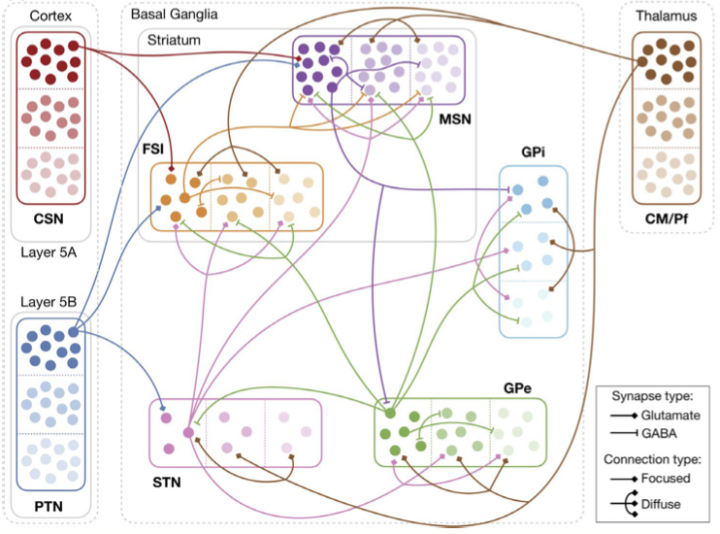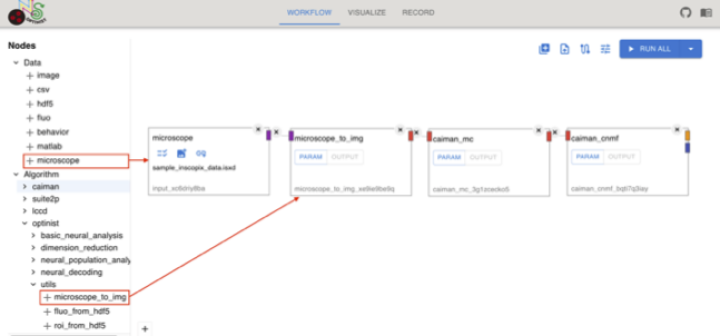We develop novel computational frameworks for neural data analysis and neural network modeling. We employ Bayesian framework to estimate unknown variables and parameters based on experimental data and prior knowledge.
Dynamical Systems Group
Neural data analysis and modeling
Large-scale spiking network models of the basal ganglia
- Carlos Gutierrez (OIST to Softbank)
- Benoit Girard (U Sorbonne)
- Jun Igarashi (RIKEN RCCS)
- Tadashi Yamazaki (U Electro-Communication)
In the projects for utilizing and planning Japan’s flagship supercomputer “Fugaku,” we developed neurobiological data constrained spiking neuron models of the basal ganglia. We converted the mean-field (firing rate) model of the basal ganglia optimized to reproduce multiple experimental conditions (Lienard & Girard 2014) into a spiking neural network model (Girard et al., 2021). The model reproduced not only the average firing rates and oscillatory rhythms, but also realized action selection by competition and populations encoding different actions.
-
Girard B, Lienard J, Gutierrez CE, Delord B, Doya K (2021). A biologically constrained spiking neural network model of the primate basal ganglia with overlapping pathways exhibits action selection. Eur J Neurosci, 53, 2254-2277. https://doi.org/10.1111/ejn.14869
- Kuniyoshi Y, Kuriyama R, Omura S, Gutierrez CE, Sun Z, Feldotto B, Albanese U, Knoll AC, Yamada T, Hirayama T, Morin FO, Igarashi J, Doya K, Yamazaki T (2023). Embodied bidirectional simulation of a spiking cortico-basal ganglia-cerebellar-thalamic brain model and a mouse musculoskeletal body model distributed across computers including the supercomputer Fugaku. Front Neurorobot, 17, 1269848. https://doi.org/10.3389/fnbot.2023.1269848
Wide-field calcium imaging
- Yukako Yamane, Staff Scientist
- Masanori Matsuzaki (U Tokyo)
- Teppei Ebina (U Tokyo)
We participated in Japan’s national neuroscience project, Brain/MINDS (https://brainminds.jp/en/) for large-scale data analysis. We analyzed wide-field calcium imaging data from the premotor to parietal cortex of marmoset monkeys acquired in Matsuzaki lab in University of Tokyo (Ebina et al., 2024). In order to characterize the calcium responses of wide cortical fields, we applied non-negative matrix factorization (NMF) to the fluorescence signal and detected tens of components from the premotor cortex (PM), primary motor cortex (M1), primary somatosensory cortex (S1), and the parietal cortex (PPC). Then to analyze dynamic interactions across these neural populations, we applied the embedding entropy (EE) method (Shi et al., 2022) and found that the causal interactions across populations strengthened through lever push/pull task training (Yamane et al., in preparation).

Software for Data Analysis and Modeling
OptiNist
As calcium imaging becomes popular, there is increased demands for applying advanced data analysis methods, comparing their results, and building data analysis pipeline in efficient and reproducible way. We developed a software tool Optical Neuroimage Studio (OptiNiSt) that allow intuitive design of data analysis pipeline through graphic user interface and producing data processing script to be deployed in computing clusters (Yamane et al., 2025).
OptiNiSt is pre-loaded with popular data analysis tools like CaImAn, Suite2p, and LCCD, and extensible by registering user-defined analysis modules in Python. The source code is available from GitHub and users can simply install by `pip` command or downloading a Docker image (see https://optinist.readthedocs.io).
- Yamane Y, Li Y, Matsumoto K, Kanai R, Desforges M, Gutierrez CE, Doya K (2025). Optical Neuroimage Studio (OptiNiSt): Intuitive, scalable, extendable framework for optical neuroimage data analysis. PLoS Comput Biol, 21, e1013087. https://doi.org/10.1371/journal.pcbi.1013087
SNNbuilder
In building complex models, keeping track of how different parameters were chosen, from experimental data, literature, previous models, or tuning by simulation, is an important issue. We developed a spiking neural network modeling tool SNNbuilder, which is based on an entity-relation database to represent a complex models (Gutierrez et al., 2022). User can register and select data through graphical user interface and generate spiking neural network simulation codes in NEST language. This will be a basis for future development of data-driven model building and simulation systems.
- Gutierrez CE, Skibbe H, Musset H, Doya K (2022). A spiking neural network builder for systematic data-to-model workflow. Frontiers in Neuroinformatics, 16, 855765. https://doi.org/10.3389/fninf.2022.855765





